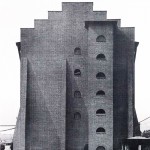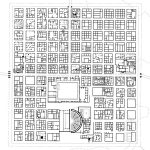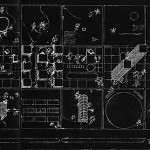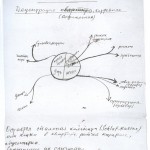In 1933, a team from Poznan University led by Polish archaeologist professor Józef Kostrzewski, started a series of excavations close to Lake Biskupin in Poland. The campaign uncovered a large Iron Age settlement, dating between 750 and 500 BC, built of timber preserved in marshland at the edge of the lake. The settlement took the form of an artificial island of over 2 hectares surrounded by 450m of timber ramparts which enclosed about 100 identical houses organized along a strict grid pattern and separated by timber streets to cover the damp, boggy ground. The whole structure was very dense and extremely regular with the houses built from standardised components. After being abandoned, the island gradually sank into the lake. Yet, as the lake progressively turned into a mashland, it had the incredible effect of preserving the wooden components of the city: streets, buildings and the defensive walls.
The single houses measured about 8 x 10m and were built from pine wood, with oak used for important structural elements. Each house had two main rooms, the largest one used as the kitchen and dining area with a stone heart in it. The rows of houses were separated by eleven 3m wide timber streets, which linked to an outer road running between the houses and the timber rampart.
The organization of the settlement provided informations about the society inhabiting it, apparently characterized by a lack of social differentiation. The fact that it was built on an island suggests the defensive scope of the settlement.
When Poland was occupied in autumn 1939, Nazis declared that the site was Germanic and renamed it “Urstädt”. A branch of the SS, called ‘SS Ahnenerbe” continued the excavations. This pseudo-scientific unit of anthropologists and scholars, under the control of Heinrich Himmler, spent the war conducting excavations in pursuit of alleged Aryan ancestors.
When the Germans were forced to retreat, they flooded the site hoping to destroy it, but, ironically, this operation led again to a very good preservation of the ancient timber. Excavations were resumed by Polish archaeologists after the war and continued until 1974.
Further reading:
Theorethical Structural Archaeology
Bensozia
Related:
Walls as Rooms /4 : The Hakka Tulou (Community Housing for Equals)






Are there paleobotanical data available for this artificial ‘island’ within the wooden ramparts that would describe the species composition of the native vegetation of the Bronze Age marshland?
Sorry, no idea, maybe you should ask the people at the Archaelogical Museum of Biskupin. http://www.biskupin.pl/
Sorry, no idea, maybe you should ask the people at the Archaeological Museum of Biskupin. http://www.biskupin.pl/